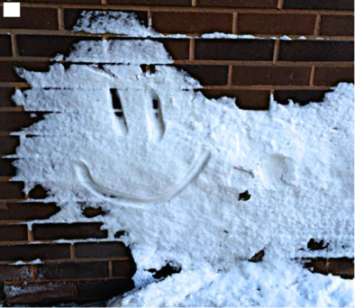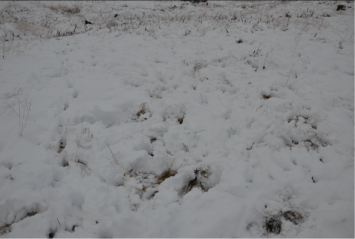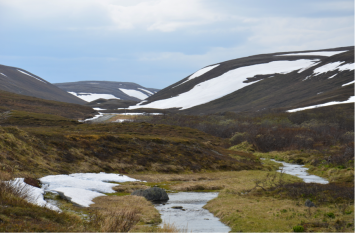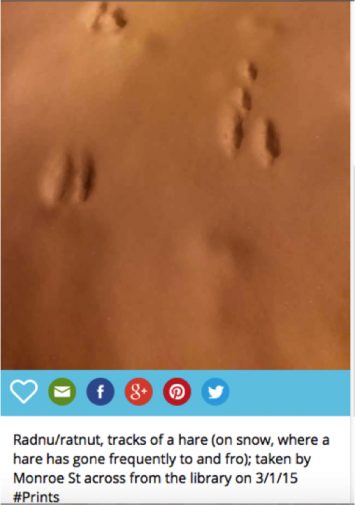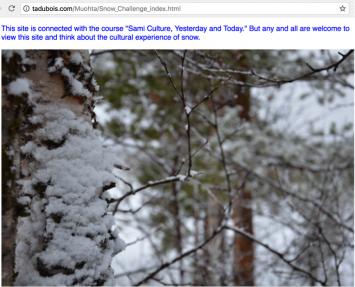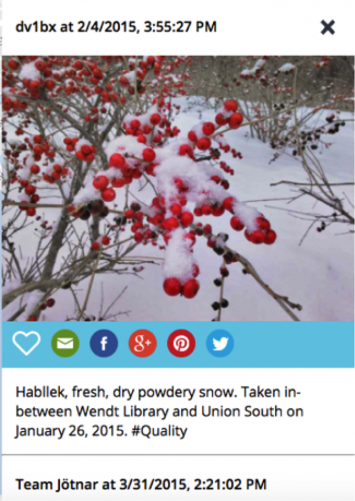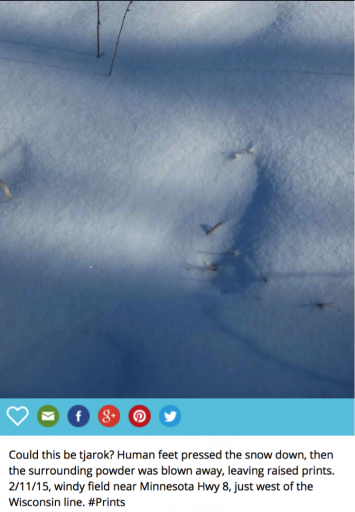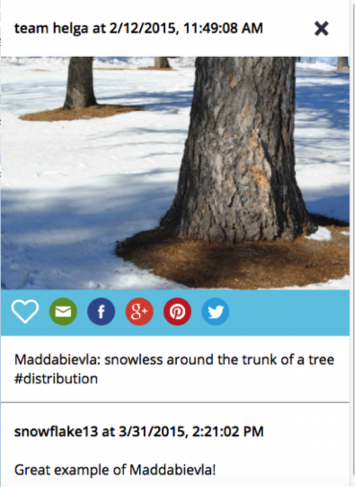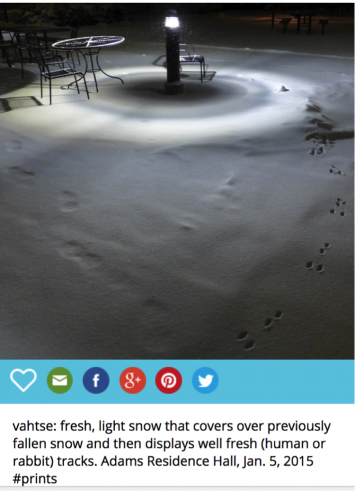Link to Table of Contents: March 2018, Decolonization Issue [2]
DuBois JSE March 2018 Decolonizing Issue PDF [3]
Abstract: This paper introduces an experiential learning assignment “Snow Challenge 2015 [4]” incorporated into an undergraduate-level interdisciplinary humanities and social science-based course focusing on a single Arctic Indigenous culture: the Sámi [Lapps] of Finland, Norway, Sweden, and the Kola Peninsula. The assignment used the open-source app Siftr [5] and an accompanying open-access informational website [6] on Sámi snow terms to allow students to apply Lule Sámi snow terminology to snow phenomena they observed in and around their home campuses and neighborhoods. The assignment’s goal was to enhance student learning related to each of the four categories of environmental literacy presented in Hollweg et al.’s (2011) framework: knowledge, attitudes, competencies, and behaviors. A content analysis of a random sampling of student essays written at the conclusion of the assignment showed significant enhancement of student learning, particularly in the areas of attitudes and competencies. The assignment helped model for students the value and nature of an Indigenous-centered curriculum and the pragmatic nature of Indigenous traditional knowledge in living effectively within a winter environment.
Keywords: Environmental literacy, traditional knowledge, Arctic cultures, Sámi studies, Siftr, experiential learning, locative technologies
Introduction
During the winter of 2015, a class of 104 American college students at three different universities used the easy-to-use, open-source app Siftr [5] to apply Lule Sámi snow terms to the visible landscape around them. Using personal cell phones or cameras to capture images of real-life snow conditions and then geolocating the images on a publically accessible map using the Siftr app, students involved in the assignment “Snow Challenge 2015 [4]” created a nuanced visual record of local snow conditions in and around Columbus Ohio, Madison Wisconsin, and Minneapolis Minnesota for a period of one month during the winter of 2015, while also learning about the utility and expressive potential of snow lexicon in a living Arctic language. The assignment helped American students “see snow” in a Sámi way and share their learning with the broader world, one that also came to include non-student interloper participants in places as far away as New Hampshire and Iceland. In a culminating individually written essay, students examined representations of snow and snow events (like winter storms) in journalistic media and interviewed one person outside of the course regarding attitudes toward snow and winter weather.
Background: Sámi Snow Research and Its Aims
Sámi (formerly called “Lapp”) people, the recognized Indigenous population of Finland, Norway, Sweden, and the Kola Peninsula of Russia, speak or have spoken a number of closely related but distinct Finno-Ugric languages, some eleven of which are known to modern linguists today. Most of these languages are endangered or nearly extinct, due to the past assimilative politics of Nordic governments and educational systems during the nineteenth and twentieth centuries. A few, like Northern Sámi and Lule Sámi, have populations of speakers numbering in the thousands. Others, like Ume Sámi and Ter Sámi, are spoken today by fewer than a hundred speakers. Under colonial pressure, many Sámi communities underwent language shift to a majority language already generations ago.
Sámi scholars, writing in northern Sámi, Nordic colonial languages, and occasionally English, have explored with elegance and precision the rich array of terms that people speaking various Sámi languages have developed in connection with snow. Cultural exploration and lexical identification of phenomena related to snow—including forms of snow precipitation, its characteristics in winter weather events, its distribution or change while lying on the ground or on ice, and ways it can be moved or marked by wind, animals’ feet, and successive processes of melting and freezing—has occurred over many centuries in Sámi languages, and remains an evolving and productive area of lexicon today (Eira et al. 2010 [7]). Formal linguistic research into snow lexicon in Sámi languages began already in the 1920s, as Konrad Nielsen conducted fieldwork for his authoritative dictionary of North Sámi, a work that remains a valuable resource for scholars today, particularly those wishing to examine Sámi languages from a historical perspective (Magga 2006 [8]). Israel Ruong (1969), the first Sámi person to earn a doctorate, wrote insightfully about Sámi traditional livelihoods and the terms used in daily life, including various snow terms in his introduction to Sámi culture. Historical linguists have discovered sometimes startling continuities for many of the terms recorded and defined in dictionaries like Nielsen’s: the North Sámi term čiegar, for instance, (or its cognate, the Lule Sámi tjiegar) today refers to snow lying on the ground that has been extensively pawed up by reindeer in their search for underlying food to graze on. The term has cognates in all other Sámi languages as well as in the more distant Finno-Ugric languages Khanty, Mansi, and Kamassian (Álgu-tietokanta Čiegar [9]; see also discussion, Magga 2014: 42).
Given what is known about the migration and divergence of Finno-Ugric languages, the term must be thousands of years old. On the other hand, sometimes the words found in Sámi languages differ strongly from each other and indicate divergent developments. The South Sámi term tsoevtse, for instance, refers to a patch of snow that remains unmelted on a hillside during the late spring or the summer (Magga 2014: [11] 32). The equivalent concept occurs in Lule Sámi language with the cognate word tsuobttsa (Álgu-tietokanta Tsuobttsa [12]) but the word in North Sámi for such a snow patch is entirely different: jassa (Álgu-tietokanta Jassa [13]). Both terms are ancient and have cognates widely in other Sámi languages or in Uralic languages from eastern Siberia, but their meanings vary: the North Sámi cognate of tsoevtse, for instance, cuokca, refers not to a patch of lingering snow on the ground but to a bridge over a river formed of snow and ice (Álgu-tietokanta Cuokca [14]). Studying the interrelations of words in various Sámi languages can allow scholars to theorize regarding the ancient connections of Sámi communities and their relations with their environment and neighboring cultures (Aikio 2004).
In the mid-1970s, as a new generation of Sámi scholars arose with the twin aspirations of deepening empirical understandings of Sámi culture and valorizing what was at the time a stigmatized and marginalized traditional culture, Nielsen’s earlier fieldwork became a resource for new diachronic and comparative studies. Interviewing older Sámi in various locales across Sápmi, the young scholars measured the degree to which earlier documented terms persisted in active use and ways in which snow lexicon varied locally and in relation to livelihood (Østby et al.) On the basis of this empirical data, they began to write studies that brought out distinctive local terminology related to snow and winter weather (e.g., Svonni 1981), and they revealed the ongoing significance of snow lexicon, particularly among Sámi involved in livelihoods that depended on a close monitoring of the local environment and conditions, including hunting, trapping, and reindeer husbandry (Eira 1984). Nils Jernsletten explored the rich lexical elaboration that Sámi languages display in relation to various specific livelihoods, not only in relation to topics like snow terminology, but also in terms of reindeer terminology and fish and seal characteristics and behavior (Jernsletten 1994, 1997). For a broader, non-Sámi Nordic readership, this research became vividly and evocatively illustrated in the work of lexicographer Yngve Ryd, who interviewed Johan Rassa, a Lule Sámi reindeer herder, and created a book full of photographs and descriptions that covers hundreds of specific Lule Sámi snow terms in a work with a deceptively simple Swedish title: Snö (snow) (Ryd 2001, retitled 2007). In the years since Ryd’s work, Ole Henrik Magga has written actively on the topic (2006, 2014) as has Anders Kintel (2010) and the team of Inger Marie Gaup Eira, Ole Henrik Magga, and Nils Isak Eira (2010). In his 2014 study of South Sámi snow terms, Magga surveys a hundred different snow terms, some fifty of which have no cognates in any other Sámi languages. This fact underscores the importance of localized, language-specific studies that involve close discussion with native speakers involved in or familiar with traditional activities.
This Sámi research should not be separated from the important Sámi agenda that motivated it. The rising scholars of the mid-1970s that embraced snow research can be seen as part of a broader artistic and intellectual movement within the Sámi community that became known by the somewhat mysterious acronym ČSV (Stordahl 1997, Kalstad 2013, Brantenberg 2014, Keviselie 2017). For Sámi of the ČSV generation, celebrating unique or highly recognizable aspects of Sámi culture became a way of embracing an enduring Sámi identity and the right of Sámi people to continue their traditions and ways of life, goals stated explicitly in a 1980 joint statement of the Nordic Sámi Council (Thuen 1995:41-42). For many of this generation, study of Sámi lexical complexity fit directly into the statement’s call for the recognition and advancement of Sámi languages, demonstrating the distinctiveness of Sámi linguistic and cultural identity.
Closely connected with the goal of valorizing Sámi language was the recognition of it as a crucial link between modern Sámi and their ancestral culture. Whether through focusing on acts of intergenerational transferral of knowledge and worldview facilitated by Sámi language, as Harald Gaski (1999) does in his classic and seminal essay “A Language to Catch Birds with [16]” or through the conscious “recovery” of a sense of Sámi continuity entailed by learning Sámi language or conducting research on Sámi topics (see discussion, DuBois 2017: 103-128), the Sámi languages have played, and continue to play, a central role in Sámi cultural activism. In a context in which Sámi language was standardly portrayed as a hindrance or primitive relic, something to be set aside in favor of the idioms of the majority culture, studies that underscore the intrinsic sophistication and expressive potential of Sámi languages become highly attractive. It may be that snow terminology has held particular appeal in this context since snow was something that was once equated with the supposedly miserable life of Sámi as viewed by outsiders. By “owning” a concept that was once used to denigrate Sámi culture, Sámi reappropriate it as a symbol of Sámi identity and confidence.
A further stated or apparent goal of Sámi snow research has been to help establish and develop the idea of Sámi traditional knowledge as a valid and equal counterpart to Western science. Because claims to scientific authority are often directly linked to the generation of policies and practices regarding environmental management in Arctic areas, a recognition of the rigor and validity of Sámi traditional knowledge as an Indigenous form of science holds potential to improve Sámi access to decision-making regarding environmental questions in Sápmi. Eira et al.’s (2010) analysis of operative empirical categories underlying Sámi snow lexicon aims to demonstrate the pragmatic, evidence-based nature of snow terms. As Sámi scholars show, knowledge is not simply discrete items of fact, but practices about what to notice, how to describe, and how to analyse. Through examining Sámi snow terminology, the researcher can arrive at the ways in which Sámi people have perceived and analyzed their environment over time. The characteristics of snow that are noted become sources of insight in themselves. For instance, an English speaker might not at first think of animal tracks as a component of snow. But once one surveys the stunning array of specific terms that Sámi have developed to describe the specific tracks of specific animals in specific types of snow, one can better appreciate the fact that for Sámi, winter was a prime season for trapping. With tracks easier to find and analyze, food resources for target animals more limited, and fur quality better, the winter was an ideal period for harvesting animals through traps and snares. Learning the term radnu for the tracks of a hare following its established daily route, as the student KennyECSnow did when posting a 3/1/2015 image (albeit of rabbit tracks; an interesting adaptation!), helps underscore the fact that what we refer to as a component of “snow” is culturally variable.
These viewpoints have been powerfully advanced in Sámi scholarship on traditional knowledge. Lars-Nila Lasko’s (1993) edited anthology of essays and Elina Helander’s (1996) edited volume contribute important insights into the workings and meanings of Sámi knowledge systems. Jelena Porsanger and Gunvor Guttorm’s (2011) edited volume provides substantive guidance for the development of ethical and effective frameworks for the collection, documentation, analysis, and use of Sámi traditional knowledge in scientific contexts. Asbjørn Aaheim’s (2009) edited volume looks at ways in which Sámi traditional knowledge can contribute to research aimed at understanding and mitigating climate change in Arctic areas, and Tim Frandy (2013) has demonstrated the resilience of Sámi traditional knowledge in comparison with lab-based Western biology in understanding complex multivariable processes of ecological change.
A final element to note in contemporary Sámi interest in snow lexicon is its value in helping articulate and populate a decolonized, Sámi-centered, holistic Sámi educational program. Jan Henry Keskitalo (2009) argues eloquently for Sámi schooling that is not simply a translation of majority culture content into Sámi language but rather, an integrated, culturally-nuanced approach that places Sámi concepts and experiences as central in students’ educational experience. Asta Mitkijá Balto (2008) presents frameworks for incorporating Sámi traditional knowledge into Sámi educational systems as an act of decolonization. Elisabeth Utsi Gaup (2009) demonstrates how curricular materials focusing on Sámi landscape and environment can be incorporated into Sámi language teaching. In connection with snow lexicon in particular, Sverre Porsanger et al. (2009) offer curricular materials to introduce Sámi snow terms and meanings in elementary and secondary school contexts. This Sámi initiative can be understood in a broader context of Indigenous educational sovereignty as developed and practiced by Indigenous communities in other parts of the world, including the Upper Midwest (Cederström et al. 2016 ).
Combatting the Snow Skeptics
This important trend within Sámi studies also happens to intersect with, and in some cases run afoul of, a widespread, and often pernicious, discussion within linguistic circles about the words that Arctic cultures have for snow. The discussion, initiated in the 1980s by anthropologist Laura Martin (1986), usefully called attention to the inaccurate ways in which anthropology and linguistics textbooks of the time exaggerated or misrepresented details of Eskimo (Inuit and Yup’ik) snow-related lexicon as examples of the ways in which languages become adapted to environmental conditions. Martin’s valuable, but in some ways flawed, analysis focused particularly on the desire of Western scholars to impress their readers through referring to the lexical elaboration of snow terminology in Arctic cultures in numerical terms, as if it were possible to concretely define an exact number of distinct lexical items referring to snow in any given culture. While making these hortatory observations, Martin asserted (erroneously) in a footnote that Eskimo languages only have two distinct roots for snow and therefore presumably lack any of the lexical elaboration or semantic complexity that linguists and anthropologists had standardly credited them with. Her study was taken up and polemicized by a linguist working primarily on English, Geoffrey Pullum (1991), who described the clichéd assertion of Eskimo lexical richness in the area of snow terminology as “the great Eskimo vocabulary hoax.” From there, linguists turned direction, abandoning the cliché of Eskimo lexical elaboration for what became an equally clichéd assertion of the lack of Eskimo lexical elaboration, one that, to readers uninformed in Eskimo languages and not following the fine points of linguists’ arguments, seemed to suggest that speakers of Eskimo languages took scarcely any notice of the snow that they have lived with for large parts of the year over many centuries. The assertion that Eskimo languages lacked such elaborate lexicon was in turn assumed in simplistic fashion to apply to all Arctic cultures, so that Sámi research on snow lexicon is often greeted with skepticism or disdain in English-speaking majority culture circles.
While linguists and journalists without specialization in Eskimo languages today continue to repeat Martin’s assertion that Eskimo languages have only two roots for snow (Martin 1986, Pullum 1991, 2011, 2013, Nunberg 1996), scholars with knowledge of Inuit and Yup’ik languages (Woodbury 1991, Kaplan 2003, Krupnik and Müller-Wille 2010), or people who have read and digested their findings (Robson 2012, 2013) have consistently, though often gently, pushed back, identifying multiple roots for snow in various Eskimo languages, and stressing the fact that such is to be expected in cultures that live and deal with snow for much of the year.
As Kaplan (2003) puts it in reference to Inupiaq snow lexicon:
Even if we exclude the sorts of terms that some have suggested should not count in our tally of snow terms, it still appears that Inupiaq at least has an extensive vocabulary for snow and ice. It would surely be a surprise if Inuit people did not pay special attention to snow and ice, which are important features of the landscape throughout most of the year. Weather conditions and the state of frozen moisture underfoot are of utmost importance to travelers, hunters, and others, for whom faulty judgment of the terrain can have severe consequences. This particular semantic area demonstrates the detailed knowledge that many Inupiat have about their natural environment, and the example could have easily been something other than snow.
Yet the desire not to be caught in a “hoax” leads many American readers today to discount the notion that Eskimo languages, or indeed any Arctic language has multiple words for snow of any sort. Most unfortunate are assertions that aver that English is superior to Arctic languages in its elaboration of snow lexicon, or mocking spoof lists of purported Eskimo words like Phil James’s “The Eskimos’ Hundred Words for Snow,” which includes entries like “hiryla snow in beards” and “wa-ter melted snow.” Such attempts at humor trivialize another culture’s traditional knowledge, while suggesting that there is really very little of real importance that can be said about snow at all. One of the reasons for creating a snow assignment in a Sámi culture course was to reverse this unfortunate and rather absurd tendency in majority-culture musings about Arctic Indigenous cultures.
The Assignment: Snow Challenge 2015
Snow Challenge 2015 was designed to be part of a one-semester course entitled “Sámi Culture, Yesterday and Today,” taught regularly at the University of Wisconsin-Madison in the winter (actually in what is called the “spring semester,” although it takes place mostly in the winter). The course’s 2015 iteration was shared electronically with the Ohio State University and the University of Minnesota-Twin Cities through a program called the Big Academic Alliance CourseShare [18]. Although taught in Madison, students in Columbus and Minneapolis participated through watching streamed video and accessing a single course website. One of the benefits of the assignment was that it allowed students in different locations to share information about local weather conditions and to compare notes on the snows of 2015, i.e., to “talk about the weather,” but in a more complex and purposeful way than that phrase often connotes.
Siftr [5] is an easy to navigate and enjoyable platform for creating place-based outdoor educational activities. It was developed by Field Day [20], an “interdisciplinary team of educational researchers, software engineers, artists, and storytellers, exploring the intersection of current learning science and media design, specializing in mobile media, video games, and simulation.” The group is based at the Wisconsin Center for Educational Research at the University of Wisconsin-Madison, and Siftr, like other products the group has produced, is offered to the public as an open-access learning and curricular tool. Educators and other users of the app create a login account before designing a Siftr activity, but many or even most of the activities that educators have generated using Siftr are open to the general public to use, as was the case with “Snow Challenge 2015 [4].” This means that non-students could see the results of students’ research and contribute themselves to the site if they chose. In order to ensure student privacy in this digital environment, students were required to adopt pseudonyms when making posts to the site app. The app also permits closed activities, however, and some educators reading this study may wish to use this option. Posts from outside a list of “invited participants” (i.e., students registered in the course who had submitted their team pseudonyms for approval), were screened for appropriate content before being made visible to the public. Student essays were not shared with the general public.
Participants were challenged to learn a small selection of distinct Lule Sámi snow terms drawn from the book Snö, compiled by Ingvar Ryd in interviews with Lule Sámi reindeer herder Johan Rassa (Ryd 2007). Because the book is written in Lule Sámi and Swedish, neither of which most of the students knew, the assignment as planned necessitated the creation of a simple website [6] where students could learn about the selected terms and see illustrations of them. Photographs of various snow phenomena in Sápmi and in Madison were used to illustrate the terms. Part of the incentive for student participants was to produce photographs of their own of sufficient quality and clarity that could potentially be added to the website. The current website includes numerous photographs by students, credited using the pseudonymous team names the students devised as part of the assignment. This permanent website makes the assignment one that can be easily replicated in other courses, or in the same UW course in future years. The assignment will be repeated in February 2018 (Snow Challenge 2018 [21]).
The website introduces some thirty lexical items from Ryd and Rassa’s anthology of nearly three hundred snow-related terms, arranged into four broad categories as listed below. Numbers in parentheses after the terms below refer to the page in the Swedish publication in which the term appears.
1. Snow texture and quality:
habllek (70) very light, fresh, dry powder snow, particularly when falling, but also when newly on the ground
slievar (71) light, loose, dry snow on ground; one sinks deeply into it making walking or skiing slow
säŋásj (73) coarse, granular snow in the middle of a snow bank that has sat for a while (“corn snow”)
tsievve (78) solid surface of snow that can bear weight without breaking; hardpack. Forms when snow has sat on the ground and been exposed to wind and sunlight for an extended period. Can be slippery.
skártta (59) hard, icy snow adhering to the ground underneath a layer of deeper snow. Forms when snow has partly melted and then refrozen, making it difficult for animals like reindeer to reach edible plants.
jäekŋa (63) ice of any sort, as differentiated from snow.
släbtsát (56) wet, slushy snow on ground.
2. Distribution on the ground or other surfaces:
bulltje snow adhering to objects.
maddabievla (230) snowless area around the trunk of a tree.
muorabievla (230) snowless area under the branches of a tree.
garvatjimbievlla (295) alternating patches of snow and ground, making skiing harder.
vádtsembievlla (242) alternating patches of ground and snow, in which it almost becomes pointless to try to ski rather than walk (more extensive than garvatjimbievlla).
stuor bievla (243) large patches of open ground, alternating with snow. Forms in the spring as snow is melting, particularly in mountains. It is no longer possible to ski in such an area (more extensive than vádstembievlla).
báhtset (164) tracks of animals, skis, or vehicles that remain after the surrounding snow has melted away and disappeared, often marking established paths or trails.
muohtarievta (247) remaining patches of snow that have not disappeared while all the surrounding snow has melted away.
3. Degree to which snow is trodden or marked by tracks or prints:
åppås (138) freshly fallen snow with no animal tracks crossing it.
vahtse (137) fresh, light snow that covers over previously fallen snow and then displays well fresh animal tracks.
tjiegar (207) abundantly pawed up snow, especially where reindeer have been digging to reach food beneath the surface.
tjuojvoj (137) hardened, extensively trodden snow showing tracks leading in all different directions.
sjádde (207) area so pawed up by reindeer that it is no longer suitable for reindeer grazing.
tjårok (184) tracks raised above the surface of the snow. Formed when animals or skis press snow down more firmly than the surrounding powder; wind subsequently blows away the surrounding snow, leaving the prints as raised areas.
doalle (154) hardened tracks or trail that has been coated in a fresh layer of snow but which still remain visible to the eye. Easier to walk or ski on doalle than on the surrounding snow.
4. Degree to which snow is easy to ski on:
radda (30) very thin coating of snow, just a little more than a dusting, in which vegetation and rocks still show through, making for poor skiing.
jådådahka (91) good snow for skiing, skis glide easily over it, sinking in just a little.
tjarvva (91) crust of snow that makes skis go fast but with less control.
smoaládahka (93) loose, icy, granular snow on the surface. Forms when snow or rain has fallen onto hard snow and then refrozen. Snow has small pebbles of ice in it.
ruhtta (93) thicker crust of ice that breaks in splinters and makes for slow skiing.
sagij (93) fresh, dry snow that is sticky to ski on. Becomes good for skiing after sitting on the ground for a day or two.
dejkarmuohta (96) moist, soft snow that clumps on skis and makes for slow, poor skiing (“mashed potatoes”); still drier and more snow-like than släbtsát
Snow terms were selected with an eye toward ones that would be clearly recognizable to the students and therefore easy to apply, and that were likely to be seen in and around an urban American college campus. Terms were avoided that were closely associated with reindeer husbandry and trapping, since these were activities that students were not likely to engage in during the semester. Terms for skiing conditions were included since recreational cross-country skiing is an important part of student life in the Upper Midwest. The terms were also selected to reflect conditions at different stages of winter, including ones having to do with abundant fresh-fallen snow (e.g., habllek, åppås, vahtse), ones reflecting snow that has lain on the ground for some time (e.g, säŋásj, tjårok, ruhtta), and ones typical of late winter and early spring (maddabievla, báhtset, muohtarievta). This range of terms would allow students to find different types of snow at different points during the month during which the assignment was proceeding, and sought to counter the (increasing) unpredictability of winter conditions in the region where the three universities are located. Several student teams also took the initiative to learn some North Sámi snow terms drawn from an article written by Nils Jernsletten (1997), and some of their uploaded images were added to the overall website as well.
In approaching the assignment, students were required to:
- Form a team of 2-4 students;
- Post as a team at least five geolocated images;
- Include in each post the type of snow depicted, the definition of the term, and an indication of where and when the photo was taken;
- Comment individually on at least three posts from other teams;
- Produce a final individual summative and evaluative essay which each student wrote and turned in separately.
Students were encouraged to take photos that would capture the visual essence of the Lule Sámi snow term in a manner that would be striking and vivid to a viewer. The images below illustrate the kinds of posts student teams were able to produce.
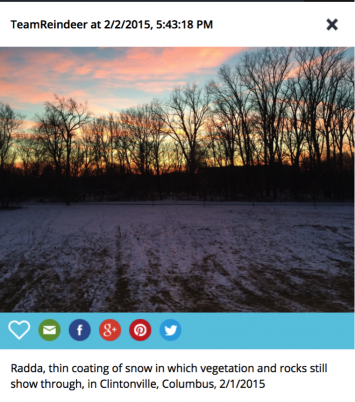 [27]Assignment Goals and Assessment
[27]Assignment Goals and Assessment
The curricular goals of the assignment were several. First, as indicated by the above discussion, the Snow Challenge sought to replace simplistic outsider understandings of Arctic snow lexicon with a more nuanced and enlightening exploration of Lule Sámi snow terms as useful and revealing. By compelling students to actually learn some of the terms and seek to find real-life examples in their local environment, the assignment sought to de-exoticize the lexicon and demonstrate its value as a means of identifying, classifying, and describing important and characteristic elements of the winter landscape. As one student remarked to me after conducting her team fieldwork, “I have lived in Wisconsin all my life and seen those bare places at the base of trees during winter all the time, but I just never noticed them before or really had a word for them. Now I can call them bievla” (personal communication). Rather than theorizing about whether English or Eskimo have “more words” for snow, or making up belittling lists or parodies, students were invited to explore and appreciate the actual snow lexicon that Sámi have developed and actively use.
Second, the assignment sought to embrace the idea of environmental education occurring outside of the classroom as well as within it. The assignment took to heart Jay Lemke’s (2004) characterization of the inadequacies of classrooms for many types of education, noting the development of institutional classrooms as an artifact of earlier eras of mass education, focused primarily on skills of basic literacy. How can “environmental literacy” be achieved in the confines of a cramped conventional classroom, with students facing forward, reading and writing, and not experiencing the surrounding environment in meaningful ways? Part of the point of the assignment was to cause students to have a reason to slow their pace between classes and classrooms, so that they could look at and appreciate the snow phenomena that surrounds them in the winter. Such attention underscores an area of overlap between the US Upper Midwest and Sápmi, helping create a basis for comparison in students’ learning about Sámi culture and their own life experiences and understandings.
Third, the assignment as conceived and realized relates directly to other research published in The Journal of Sustainability Education. On a fundamental level, the Snow Challenge assignment aimed at increasing students’ awareness of the winter environment and their attitudes toward it. King and Franzen (2017) demonstrate that higher education courses in environmental literacy have a significant effect on students’ self-perceptions of their awareness of the environment and its complexities. Using Hollweg et al.’s (2011) framework for defining environmental literacy, King and Franzen’s study showed that students who had completed an environmental education course displayed increased awareness in a range of different areas, including cognizance of environmental concepts, problems and issues, and the development of active attitudes toward personal and societal behaviors that can lead to a healthier environment. Further, in a curricular case study, Robin Reid (2013 [28]) details an assignment aimed at getting students to reflect on personal and societal relations with the environment. Reid shows how asking students to monitor their personal vehicle use over a period of days and write journal essays about it can help raise student awareness of the ways in which personal behaviors affect the environment, but also how societal norms influence one’s views of what is “normal” or “right” or “necessary” to do. In a similar manner, one of the implicit goals in the Snow Challenge assignment was to get students to notice how society seems to encourage people to view snow as an impediment, inconvenience, or danger, rather than as a biological, environmental, recreational and aesthetic resource. By giving students a reason to pause and linger in the snow, and to truly observe it, the assignment sought to disrupt the ways in which American adult life seeks to erase snow from active notice or contemplation, even in a “spring semester” held during the winter in one of the snowiest regions of the US Lower 48.
A final element of the Snow Challenge was a personally written essay, again based on fieldwork. Students were required to find two instances of journalistic discussion of snow or snow events appearing that same month and interview one person about that person’s views of snow and winter. In their essay they were to relate these instances to what they had learned about snow through participating in the Snow Challenge. After the conclusion of the course, a random sampling of 25 of the 99 essays submitted were thematically analyzed to see the degree to which they spontaneously articulated viewpoints reflective of Hollweg et al.’s definition of the components of environmental literacy. Not surprisingly, given the unfamiliarity of Sámi languages to most of the students, essays did not evince a strong adoption of Lule Sámi snow terminology as a permanent element of personal environmental knowledge. On the other hand, knowledge of the ways in which snow changes when sitting on the ground over time was noted by a small number of sampled papers (20%) and students in general noted the validity and value of specific snow lexicon for effective living in winter environments. Essays evinced a clear (68%) articulation of increased critical skills regarding media representations of winter weather phenomena, and a clear articulation (76%) of an intention to embrace winter conditions more actively in the future, a measure of behavioral change. Sampled student essays showed strong indications of increased overall awareness of snow and the environment as a positive element of life (84%), indicative of changes in attitude correlating with the dispositional component of environmental literacy. In future iterations of this assignment, more concrete measures of student advances in environmental literacy will be introduced to augment and verify the findings of this pilot study.
In protests connected with the 2015 Paris Climate Summit, Indigenous activists sought and gained the privilege of leading the mass march of protestors. Environmentalists’ recognition of the importance of climate change issues for Indigenous communities in particular was thus underscored in media images circulated widely in the press and on social media. Yet often, Western scientists tend to view or represent Indigenous people as passive victims or colorful exotics, trying to live in the past. Among members of Dominant societies, as noted above, abundant Indigenous snow lexicon is seen as nonexistent (a “hoax”), mildly amusing, or antiquated. In this context, the idea of sharing Lule Sámi snow terminology with American college students holds powerful potential. It can help remind students that scientific knowledge of substantial complexity exists in many cultures, and that traditional knowledge, although inherited from the past, is also an integral and essential part of the present and (hopefully) the future. Sustainability education should, and indeed must help students—Indigenous and non-Indigenous alike—understand the rich resources that Indigenous cultures offer in the struggle to achieve more sustainable ways of living—a struggle that must begin with learning to see the environment in a more nuanced and receptive manner.
Dedication
This article is dedicated to the memory of Mr. Wayne Valliere Jr., an exuberant and talented young Anishinaabe man, filled with love for the environment, knowledge of and respect for Ojibwe traditional knowledge, and enthusiasm for education. His life was tragically cut short at the age of 25 in December 2017, and we are all poorer for that loss.
Works Cited
Aaheim, Asbjørn (ed.). 2009. Konsekvenser av klimaendringer, tilpasning og sårbarhet i Norge. Rapport til Klimattilpasningsutvalget. CICERO Report 2009:04. Oslo: CICERO Senter for klimaforskning.
Aikio, Ante. 2004. “An essay on substrate studies and the origin of Saami.” In Etymologie, Entlehnungen und Entwicklungen. Festschrift für Jorma Koivulehto zum 70. Geburtstag. Ed. Irma Hyvärinen, Petri Kallio, and Jarmo Korhonen. Mémoires de la Société néophilologique de Helsinki Tome LXIII. Helsinki: Société Néophilologique. 5–34.
Álgu-tietokanta. Kotimaisten kielten keskus. “Čiegar [9]” “Tsuobttsa [12]” “Cuokca [14]” “Jassa [13]”
http://kaino.kotus.fi/algu/index.php?t=sanue&lekseemi_id=14278&hakusana=%C4%8Diegar&sanue_id=5455 [9]
http://kaino.kotus.fi/algu/index.php?t=sanue&lekseemi_id=40621&hakusana=tsuobttsa&sanue_id=18363 [12]
http://kaino.kotus.fi/algu/index.php?t=sanue&sanue_id=18362 [14]
http://kaino.kotus.fi/algu/index.php?t=sanue&lekseemi_id=31579&hakusana=jassa&sanue_id=25997 [13]
Balto, Asta Mitkijá. 2008. “Sámi oahpaheaddjit sirdet árbevirolaš kultuvrra boahttevaš buuovvaide—Dekoloniserema akšuvdnadutkamuš Ruoŧa beale Sámis” Dieđut 4-2008. Guovdageaidnu: Sámi allaskuvla.
Big Academic Alliance. CourseShare. https://www.btaa.org/resources-for/students/shared-courses/courseshare/introduction [18]
Brantenberg, Terje. 2014. “The Politics of Belonging—The Sámi Movement.” In Sámi Stories: Art and Identity of an Arctic People. Ed. M. A. Hauan. Tromsø: Tromsø University Museum and Orkana Akademisk. Pp. 37-56.
Cederström, B. Marcus, Colin Gioia Connors, Thomas A. DuBois, and Tim Frandy. 2016. “Heritage Repatriation and Educational Sovereignty at an Ojibwe Public School” [29]Journal of Folklore and Education 3 (2016): 31-41.
DuBois, Thomas A. 2017. Sacred to the Touch: Nordic and Baltic Religious Wood Carving. New Directions in Scandinavian Studies. Seattle: University of Washington Press.
Eira, Nils Isak. 1984. “Boazobargi giella” Dieđut 4-2008. Guovdageaidnu: Sámi allaskuvla.
Eira, Inger Marie Gaup. 2012. Muohttaga jávohis giella. Sámi árbevirolaš máhttu muohttaga birra dálkkádatrievdanáiggis. The Silent Language of Snow [30]. [30]Sámi traditional knowledge of snow in times of climate change [30]. Čálus grádii/ A dissertation for the degree Philosophiae Doctor, Institutt for språkvitenskap, Fakultet for humaniora, samfunnsvitenskap og lærerutdanning, Universitetet i Tromsø.
https://munin.uit.no/handle/10037/9843 [30]
Eira, Inger Marie Gaup, Ole Henrik Magga, and Nils Isak Eira. 2010. “Muohtatearpmaid sisdoallu ja geavahus [7]” Sámi dieđalaš áigečála 2/2010: 3-24.
http://site.uit.no/aigecala/files/2014/06/SDA-2-2010-eira-ja-magga-ja-eira.pdf [7]
Field Day Lab. https://fielddaylab.org/ [20]
Frandy, Tim. 2013. “Harvesting Tradition: Subsistence and Meaning in the Northern Periphery” Ph.D. dissertation, University of Wisconsin-Madison.
Gaup, Elisabeth Utsi. 2009. “Duovdagiid giella – Bálggesčuovga lunddolaš oahppanarenaid ozadettiin sámegiela oahpahusa olis [31]” Sámi dieđalaš áigečála 1/2 (2009):46-61.
http://site.uit.no/aigecala/sda-1-2-2009_gaup/ [31]
Gaski, Harald. 1999. “A Language to Catch Birds with [16]” Weber. The Contemporary West. 16.2 (Winter 1999). https://weberstudies.weber.edu/archive/archive%20C%20Vol.%2016.2-18.1/Vol.%2016.2/haraldgaski.html [16]
Helander, Elina (ed.) 1996. “Awakened Voice. The Return of Sami Knowledge” Dieđut 4-1996. Guovdageaidnu: Sámi allaskuvla.
Hollweg, K.S., J.R. Taylor, R.W. Bybee, T.J. Marcinkowski, W.C. McBeth, P. Zoido. 2011. Developing a Framework for Assessing Environmental Literacy [32]. Washington, D.C.: North American Association for Environmental Education.
https://cdn.naaee.org/sites/default/files/devframewkassessenvlitonlineed.pdf [32]
James, Phil. N.D. “The Eskimos’ Hundred Words for Snow [33]” http://ontology.buffalo.edu/smith/varia/snow.html [33]
Jernsletten, Nils. 1994. “Tradisjonell samisk fagterminologi.” In Festkrift til Ørnulf Vorren. Tromsø Museums skrifter XXV. Tromsø: Tromsø Museum/Universitetet i Tromsø.
_____. 1997. “Sami Traditional Terminology.” In Sami Culture in a New Era. Ed. Harald Gaski. Kárášjohka: Davvi Girji. Pp. 86-108.
Nielsen, Konrad. 1979. Lapp Dicionary. Oslo: Universitetsforlaget.
Kalstad, Johan Klemet Hætta. 2013. “ČSV–Sámi nationalisttaid dahje sámenašuvnna doaimmalaiččaid muitun [34].” Sámi dieđalaš áigečála 1/2013: 29-48..
http://site.uit.no/aigecala/files/2013/12/SDA-1-2013-johan-klemet-haetta-kalstad.pdf [34]
Kaplan, Lawrence. 2003. “Inuit Snow Terms: How Many and What Does It Mean?” In Building Capacity in Arctic Societies: Dynamics and Shifting Perspectives. Proceedings from the 2nd IPSSAS Seminar, Iqaluit, Nunavut, Canada, May 26-June 6, 2003. Ed. François Trudel. Montréal: CIÉRA—Faculté de Sciences Sociales, Université Laval. Accessed via Alaska Native Language Center. https://www.uaf.edu/anlc/snow/ [35]
Keskitalo, Jan Henry. 2009. “Sámi máhttu ja sámi skuvlamáhttu: teorehtalaš geahčastat” Sámi dieđalaš áigečála 1/2 (2009):62-75.
Keviselie, Hans Ragnar Mathisen. 2017. “Art and Sámi Revitalization [36]”
http://www.keviselie-hansragnarmathisen.net/141466666 [36]
King, Jordan A. and Rebecca L. Franzen. 2017. “Environmental Literacy in Environmentally Themed Higher Education Courses [37]” Journal of Sustainability Education 13: March 30, 2017.
Kintel, Anders. 2010: Báhkogirjje julevsámes dárruj. (Båddåsasj almodus). Divtas-vuodna: Sámediggi.
Krupnik, Igor, and Ludger Müller-Wille. 2010. “Franz Boas and Inuktitut Terminology for Ice and Snow: From the Emergence of the field to the “Great Eskimo Vocabulary Hoax”. In Knowing our Ice. Ed. Igor Krupnik, Claudio Aporta, Shari Gearheard, Gita J. Laidler and Lene Kielsen Holm. Dordrecht: Springer. Pp. 385–409.
Lasko, Lars-Nila (ed.). 1993. “Seminarium om traditionell samisk kunskap og forskning” Dieđut 5-1993. Guovdageaidnu: Sámi allaskuvla.
Lemke, Jay. 2004. “The Literacies of Science” In Crossing Borders in Literacy and Science Instruction. Ed. E. Wendy Saul. Newark, DE: International Reading Association and Arlington, VA: NSTA Press. Pp. 33-47.
Magga, Ole Henrik. 2006. “Diversity in Saami Terminology for Reindeer and Snow [8]” International Social Science Journal 58/187: 25-34.
http://www.arcticlanguages.com/papers/Magga_Reindeer_and_Snow.pdf [8]
_____. 2014. “Lullisámegiela muohtasánit [11]” “Lullisámegiela muotasánit” Sámi dieđalaš áigečála 1/2014: 27-49.
http://site.uit.no/aigecala/files/2015/03/SDA-1-2014-magga.pdf [11]
Martin, Laura. 1986. “Eskimo Words for Snow: A Case Study in the Genesis and Decay of an Anthropological Example” American Anthropologist, New Series, 88/2: 418-423.
http://languagelog.ldc.upenn.edu/myl/llog/LauraMartinEskimoSnowWords.pdf [38]
Nunberg, Geoffrey. 1996. “Snowblind” Natural Language & Linguistic Theory Vol. 14, No. 1 (Feb., 1996), pp. 205-213 http://people.ischool.berkeley.edu/~nunberg/snow.html [39]
Østby, E., I. Mysterud, N. Jernsletten, and N. I. Eira. 1976: Samisk is-og snø- terminologi. Archived materials resulting from the project “Samisk snøterminologi,” Nordisk kollegium for terrestrisk økologi. Guovdageaidnu: Sámi Instituhtta.
Porsanger, Jelena, and Gunvor Guttorm. 2011. Working with Traditional Knowledge: Communities, Institutions, Information Systems, Law and Ethnics. Dieđut 1-2011. Kautokeino: Sámi allaskuvla.
Porsanger, Sverre, Samuli Aikio, and Jill Anne Aslaksen. 2009. Spildis Bivlii. Muohta- ja dálvesániid čoakkáldat. Snø og vinterord i utvalg. Deatnu: Deanu giellagáddi.
Pullum, Geoffrey. 1991. The Great Eskimo Vocabulary Hoax and Other Irrelevant Essays on the Study of Language. [40] Chicago: The University of Chicago Press. Online link [41].
http://users.utu.fi/freder/Pullum-Eskimo-VocabHoax.pdf [41]
____. Nov. 15, 2011. “More Linguistic Slush for the Arctic”
https://www.chronicle.com/blogs/linguafranca/2011/11/15/arctic_slush [42]
____. January 15, 2013. “Bad Science Reporting Again: The Eskimoes Are Back”
http://languagelog.ldc.upenn.edu/nll/?p=4419 [43]
Reid, Robin. 2013. “Developing Curriculum that Engages Students in Evaluating Their Relationship with the Natural Environment [44]” Journal of Sustainability Education February 5, 2013.
Robson, David. December 18, 2012. “Are There Really 50 Eskimo Words for Snow?” New Scientist https://www.newscientist.com/article/mg21628962.800-are-there-really-50-eskimo-words-for-snow/ [45]
____. January 21, 2013. “Eskimo Argument Is a Snowstorm in a Teacup” New Scientist
https://www.newscientist.com/blogs/shortsharpscience/2013/01/snowstorm-in-a-teacup.html [46]
Ruong, Israel. 1969, 1982. Samerna i historian och nutiden. Stockholm: BonnierFakta.
Ryd, Yngve 2007: Snö: Renskötaren Johan Rassa berättar. Stockholm: Natur og Kultur.
Siftr. Index page. https://siftr.org/ [5]
Snow Challenge 2015. Sifr site. https://siftr.org/snowchallenge/ [4]
Snow Challenge 2018. Siftr site. https://siftr.org/30806 [21]
Snow Challenge Index. http://tadubois.com/Muohta/Snow_Challenge_index.html [6]
Stordahl, Vigdis. 1997. “Sami Generations.” In Sami Culture in a New Era: The Norwegian Sami Experience. Ed. Harald Gaski. Kárášjohka, Davvi Girji. Pp.143-154.
Svonni, Mikael. 1981. Väder- och snöterminologi i Leavassamiskan. Spesialarbete i samisk. Umeå: Umeå universitet.
Thuen, Trond. 1995. Quest for Equity: Norway and the Saami Challenge. St John’s, Newfoundland, Institute of Social and Economic Research, Memorial University of Newfoundland.
Woodbury, Anthony C. 1991. “Counting Eskimo Words for Snow: A Citizen’s Guide.” Fairbanks: Alaska Native Language Center.
